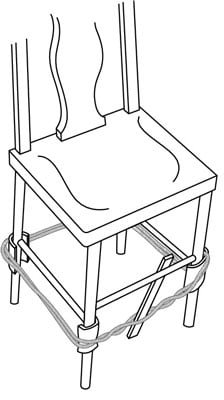Some chairs and tables are fitted together with a piece of wood (dowel rod) that runs from one leg to another. The dowels are glued into holes cut into the legs. When a dowel rod becomes loose, you can’t simply take it out and reglue it. If you remove just one dowel, you risk splitting or cracking the others. It’s better to take all the joints apart and glue them at the same time.
You need clear furniture glue and clamps. You can use C-clamps, a length of rope or clothesline, or ratchet straps:
Disassemble the legs by gently twisting the dowel back and forth to break the bond of the old glue.

Carefully inspect each joint, looking for nails and screws that may have been used to reinforce the joint. They may be hidden on the underside or backside of the piece. Sometimes they’re deliberately hidden by being countersunk below the surface of the leg. When a nail or screw is countersunk, the assembler usually fills the hole with a wood or plastic patch matched to the finish of the piece. Look for a slight roughness in the finish where the hole has been patched.
If the dowel shows any damage at all, replace it.
Using hot water or vinegar, remove the old glue.
Yes, all of the glue must be removed before you reglue the pieces in place. If any residue is left, it will weaken the bonding qualities and effectiveness of the new glue.
When you’re ready to reglue, squirt the glue into the hole and spread it around to make sure it coats all surfaces.
When you’re purchasing glue, look for one that is clear or invisible after it dries. Two-part epoxy glue is exceptionally strong and the best product for gluing dowels. However, it sets up unexpectedly and sometimes exceptionally fast. And after it sets, you can’t break it loose because the glue is stronger than the wood. Beginners who want to use epoxy should purchase only “extended-working-time” epoxy.
Place more glue on the tips of the dowels.
You get a stronger bond if both the tip of the dowel and the hole you place it in are completely coated with glue. Use a toothpick or small screwdriver to spread it around. Another way to make sure everything’s evenly coated is to insert the dowel into the hole and rotate it gently.
Push the dowel securely into place.
Read the labels to find out which glue is right for your project. A rule of thumb to guide you is that if wood joints are snug fitting, carpenter’s glue will work. If they’re loose, use epoxy.
Wrap the clothesline twice around and between each pair of legs and then tie a knot in the rope.
You can do this with bar or C-clamps if you prefer.
Insert a stick between the two pieces of rope that stretch from one leg to another. Twist the stick to tighten the ropes, gently increasing the pressure until the ropes are taut.

Before you twist the rope, put a piece of cardboard under it and around each leg to avoid damaging the wood finish.
Let the glue dry and set.
Leave the chair alone overnight, remove the clamps or clothesline, and then have a seat!

